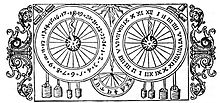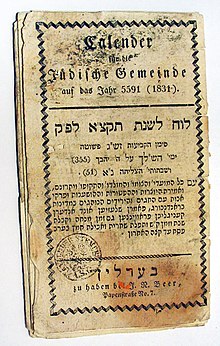Calendar
![]()
This article deals with the system of dividing time into years, months, days. For other meanings, see Calendar (disambiguation).
Today is:
Friday,
25.
June 2021
25. WEEK
![]()
This article or section is still missing the following important information:
It lacks an article on conversion between common calendars or a link to it.
Help Wikipedia by researching and adding them.
A calendar is an overview of the days, weeks and months of a year. An obsolete term is Jahrweiser.
The word "calendar" comes from the Latin calendarium (debt book). This was a list of the kalendae, the first days of the ancient months to be called out (calare "to call out"). On these days loans were disbursed and loan repayments and interest claims were due.
Today is:
Friday
25. June2021
n. d. Z.
15. tammusAM
5781
[UPDATE]
Today's date according to the
Islamic calendar:
15 Dhū l-Qaʿda 1442
(= June 25, 2021)
[update.]
There are different calendar systems, today the Gregorian calendar is predominantly in use world-wide.
Calendars come in various forms - printed, illustrated, electronic (see also Calendar).
The rules for setting up calendars result from astronomical conditions (phases of the moon, solar year) and corresponding calendar calculations. The scientific study of calendars is a branch of astronomical chronology. The pre-scientific art of creating calendars is called hemerology.
History
Origin of the calendar system
Paleolithic
Knowledge of regularly occurring animal migrations was already important for early hunter cultures.
An awareness of seasonally and astronomically repeating events, for corresponding cycles of his environment, man may have had very early. This included the change of day and night and the phases of the moon. Seasonal climate fluctuations played an important role in the agriculture of most regions of the world and could be perceived by man at the latest in the Paleolithic Age. An observation of the changes in the night sky as well as the proper movements of the planets was also possible at this time.
Settlement and Neolithic Age
The Tower of Jericho from the 9th millennium BC already indicates knowledge of the summer solstice, and Neolithic buildings such as Stonehenge bear witness to the efforts of the settled population to be able to precisely determine the natural length of the year and selected cyclically recurring celestial events such as the solstice and the equinox. For agriculture in particular, it was important to be able to determine the time of sowing and harvesting independently of the actual weather conditions. Religious fertility cults were connected with the systematic observation of the sky - based on the hope of a favourable return of fertility conditions. Thus, certain agricultural dates were tied to festivals, which in turn were linked to celestial events.
For the transition from hunter cultures to agriculture in the Neolithic period (New Stone Age), a change in calendrical ideas from the lunar to the solar calendar is assumed. This Stone Age calendar, also called the Neolithic calendar (by Alexander Thom also called the megalithic calendar) probably contains the oldest calendrical ideas of mankind and is the basis of later calendar variants. Analogous to the concept of the Neolithic Revolution (transition to agriculture) is also spoken of the Neolithic Calendar Revolution.
Copper and Bronze Age
The oldest calendars still known today come from the early advanced civilizations of Egypt and Mesopotamia. Here, two basic types of calendars were already apparent, which still characterize most calendar systems today: the lunar calendar oriented to the phases of the moon and the astronomical calendar, which reflects the course of the heavenly bodies.
At the latest by the Babylonians, the seven-day weekly cycle was developed, which today regulates the course of everyday life almost worldwide. In other calendars there were similar cycles, between five and ten days.
The adaptation of weeks and month sequences to the fixed size of the astronomical year was not easy to solve. It came to the formation of different calendar systems.
Observation calendar
Early calendar systems were obtained by observation (astronomical calendars). With the occurrence of a certain defined celestial event (e.g. the new moon or the equinox in spring) a new cycle began. They had to be regularly readjusted.
This method had a decisive disadvantage: In large dominions an event could be perceived at different places possibly at different times, so that also different dates were counted. If, on the other hand, the occurrence of an event was only decisive at a certain place (e.g. the capital or the main temple), then areas far away could often only be informed of it days later. Such problems existed, for example, in the earlier Jewish calendar, where the high priest decided on the first sighting of the crescent moon at new moon. Due to the long information paths, it could happen that a religious festival was celebrated on the "wrong" day in remote areas. Also, shortly before the end of the month it was not possible to predict which date would be, for example, in seven days, because the new moon was not calculated in advance, but determined by daily observation.
More and more cultures therefore began to calculate their calendars. The last serious attempt to establish an observational calendar was made during the French Revolution (French Revolutionary Calendar).
Calendar calculation
The calculation of calendars (arithmetic calendars) requires extensive astronomical and mathematical knowledge. In the development of the early Egyptian astral Sothic calendar, this knowledge was available. The introduction of an Egyptian administrative calendar on a 365-day basis followed at the latest in the third millennium B.C. This, however, could not prevent the passing of the seasons. The Egyptian kings complained about the shifting of the seasons, but it was not until 238 BC that Ptolemy III made an attempt to introduce a leap day. After his death, however, the old Egyptian administrative calendar was again used alongside the new leap day calendar. The Julian calendar, which was introduced by Julius Caesar in 45 BC, was nevertheless based on the calendar form of Ptolemy III.
Switching days
→ Main article: Leap year
Both lunar and solar calendars must operate with leap days, or different lengths of months, inserted into the normal calendar cycle according to a fixed mathematical rule. A solar calendar normally requires an extra day approximately every four years (in the Gregorian calendar, this is February 29) to adjust the average number of days to the length of the solar year. A lunar calendar must vary the lengths of the months between 29 and 30 days, because the time between two equal lunar phases lasts on average about 29.531 days.
The insertion of an additional day, month, or year into a calendar system is called an embolism (ancient Greek ἐμβάλλειν "to turn on").

Astronomical calendar clock (ill.) from Uppsala (Sweden)
Calendar Systems
→ Main article: Calendar systems
Lunar calendar
→ Main article: Lunar calendar
Lunar calendars are based on the phases of the moon. The German word Monat is etymologically derived from moon. However, apart from the name, the month of the Gregorian calendar has nothing more to do with the lunar cycle, since with an average length of 30.437 days it lasts almost one day longer than the average synodic month.
The disadvantage of a pure lunar calendar is that it cannot correspond to the solar year, a characteristic that in subtropical and tropical latitudes often does not have the importance it has in cultures dependent on the seasons. Thus, in the best-known lunar calendar still in use today, the Islamic calendar, the 12-month year lasts an average of 354.372 days. The Islamic months "wander" thereby year for year approximately eleven days in the Gregorian calendar forward. Also the date of Easter follows a lunar calendar (Computus (Easter calculation)).
Solar calendar
→ Main article: Solar calendar
Most cultures based their timekeeping on the seasons determined by the sun (solar or solar calendar). Accordingly, the basic type of solar calendar has produced the most variants. The solar year is oriented to the tropical year, the orbit of the earth around the sun related to the vernal equinox. This is the starting point for the general concept of the year. The Gregorian calendar, which is used worldwide today, is a solar calendar.
Lunisolar calendar
→ Main article: Lunisolar calendar
The lunisolar calendar represents the attempt to adapt a pure lunar calendar to the solar year. Since the length of the months is determined by the phases of the moon, no leap days can be inserted as with the solar calendar. The solution lies in the insertion of leap months. The annual length of lunisolar calendars therefore varies between about 353 and about 385 days. Well-known lunisolar calendars are the Jewish, the traditional Chinese and the Celtic calendar.
Other systems
There are only a few known calendar systems that are oriented neither to the moon nor to the sun. The astronomical Egyptian calendar was based on the very bright star Sirius. The Mayan calendars were based on a regular sequence of 20 days and a 52-year calendar round.

Jewish community calendar from 1831
Search within the encyclopedia